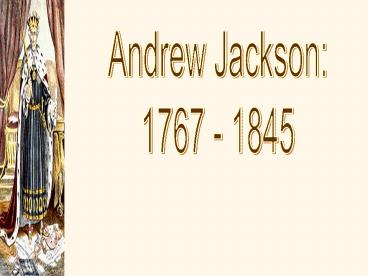Andrew Jackson - PowerPoint PPT Presentation
1 / 39
Title:
Andrew Jackson
Description:
Title: Andrew Jackson Author: Susan M. Pojer Last modified by: McLeran Created Date: 7/1/2005 1:51:51 PM Document presentation format: On-screen Show (4:3) – PowerPoint PPT presentation
Number of Views:290
Avg rating:3.0/5.0
Title: Andrew Jackson
1
Andrew Jackson 1767 - 1845
2
Essential Question Was he
Champion of the Common Man?
KingAndrew?
OR
3
What were the democratic trends in the 19c?
4
Voting Requirements in the Early 19c
5
Voter Turnout 1820 - 1860
6
Why Increased Democratization?
- White male suffrage increased
- Party nominating committees.
- Voters chose their states slate of Presidential
electors. - Spoils system.
- Rise of Third Parties.
- Popular campaigning (parades, rallies, floats,
etc.) - Two-party system returned in the 1832 election
- Dem-Reps ? Natl. Reps.(1828) ? Whigs
(1832) ? Republicans (1854) - Democrats (1828)
7
Jackson's First Presidential Run
8
The Common MansPresidential Candidate
9
Jacksons Opponents in 1824
Henry ClayKY
John Quincy AdamsMA
John C. CalhounSC
William H. CrawfordGA
10
Results of the 1824 Election
A Corrupt Bargain?
11
What were the key issues in 1828?
12
Rachel Jackson
Final Divorce Decree
13
1828 Election Results
14
The Center of Population in theCountry Moves WEST
15
The New Jackson Coalition
- The Planter Elite in the South
- People on the Frontier
- State Politicians spoils system
- Immigrants in the cities.
16
Jacksons Faith in the Common Man
- Intense distrust of Easternestablishment,
monopolies, special privilege. - His heart soul was with theplain folk.
- Belief that the common man was capable of
uncommon achievements.
17
The Reign of King Mob
18
The Peggy Eaton Affair
19
The Nullification Issue
20
The Webster-Hayne Debate
Sen. Daniel WebsterMA
Sen. Robert HayneSC
21
1830
Webster Liberty and Union, now and
forever, one and inseparable.
Jackson Our Federal Unionit must be
preserved.
Calhoun The Union, next to our liberty,
most dear.
22
The Tariff Issue
23
1832 Tariff Conflict
- 1828 --gt Tariff of Abomination
- 1832 --gt new tariff
- South Carolinas reaction?
- Jacksons response?
- Clays Compromise Tariff?
24
Jackson's Native-American Policy
25
Indian Removal
- Jacksons Goal?
- 1830 ? Indian Removal Act
- Cherokee Nation v. GA (1831) domestic
dependent nation - Worcester v. GA (1832)
- Jackson John Marshall has made his
decision, now let him enforce it!
26
The Cherokee Nation After 1820
27
Indian Removal
28
Jacksons Professed Love forNative Americans
29
Renewing the Charter of the 1st National Bank
30
Jacksons Use of Federal Power
VETO
1830 ? Maysville Road project in KY
state of his political rival, Henry
Clay
31
The National Bank Debate
PresidentJackson
NicholasBiddle
32
Opposition to the 2nd B.U.S.
Soft(paper)
Hard(specie)
- state bankers feltit restrained theirbanks from
issuingbank notes freely. - supported rapid economic growth speculation.
- felt that coin was the only safecurrency.
- didnt like any bankthat issued banknotes.
- suspicious of expansion speculation.
33
The Monster Is Destroyed!
- pet banks?
- 1832 ? Jackson vetoed the extension of
the 2nd National Bank of the
United States. - 1836 ? the charter expired.
- 1841 ? the bank went bankrupt!
34
The Downfall of Mother Bank
35
An 1832 Cartoon KingAndrew?
36
1832 Election Results
Main Issue?
37
The Specie Circular (1936)
- wildcat banks.
- buy future federalland only with gold orsilver.
- Jacksons goal?
- Curb Inflation
38
Results of the Specie Circular
- Banknotes loose their value.
- Land sales plummeted.
- Credit not available.
- Businesses began to fail.
- Unemployment rose.
The Panic of 1837!
39
The 1836 Election Results
Martin Van Buren Old KinderhookO. K.





![Read [PDF] Andrew Jackson: His Life and Times PowerPoint PPT Presentation](https://s3.amazonaws.com/images.powershow.com/10123001.th0.jpg?_=20240906097)

![Download [PDF] Patriotic Fire: Andrew Jackson and Jean Laffite at the PowerPoint PPT Presentation](https://s3.amazonaws.com/images.powershow.com/10119377.th0.jpg?_=20240903115)


![[PDF READ] Free Patriotic Fire: Andrew Jackson and Jean Laff PowerPoint PPT Presentation](https://s3.amazonaws.com/images.powershow.com/10117916.th0.jpg?_=20240902062)




















